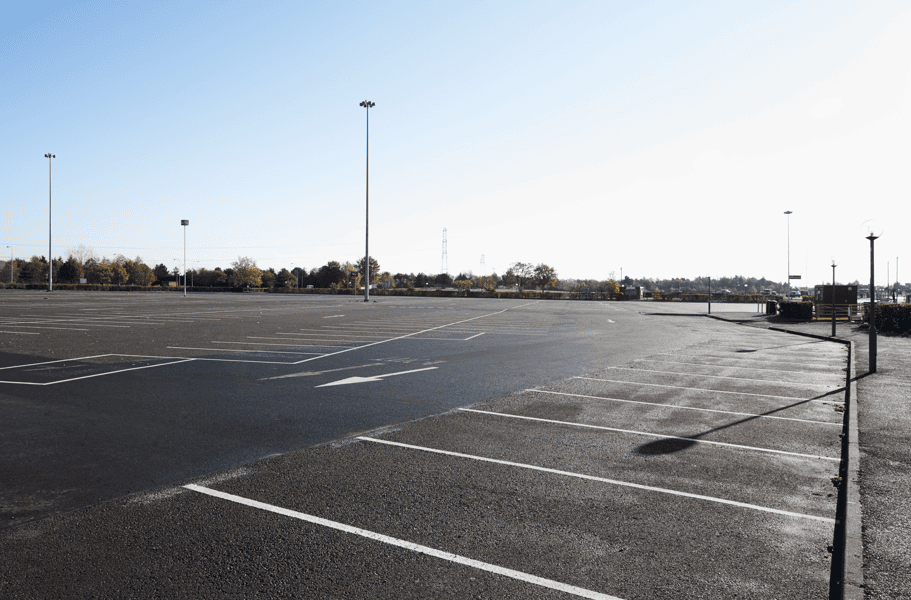Keeping your parking lot in top condition is about more than just appearances. It’s a matter of safety, longevity, and long-term cost savings. One of the most common maintenance decisions property managers face is whether or not to sealcoat their asphalt surface. But is it worth the investment? Let’s take a look at some factors to consider before sealcoating your parking lot.
What is sealcoating?
Sealcoating is the process of applying a protective coating to asphalt pavement to shield it from damaging elements like UV rays, moisture, chemicals, and vehicle traffic. Typically made from a coal tar or asphalt-based emulsion, the sealcoat acts like sunscreen for your parking lot, helping extend its lifespan and maintain its appearance.
The Benefits of Sealcoating Your Parking Lot
Benefits of sealcoating your parking lot include the following.
Prolongs Pavement Life
Regular sealcoating can extend the life of your asphalt by preventing oxidation and reducing damage from water infiltration, oil spills, and freeze-thaw cycles. Without protection, asphalt can begin to crack, crumble, or degrade within just a few years.
Improves Curb Appeal
First impressions matter. A freshly sealcoated parking lot looks smooth, dark, and clean, instantly enhancing the overall look of your property. This can be especially important for retail centers, office buildings, or healthcare facilities where customer perception is critical.
Reduces Repair Costs
Water, weather, and oil can wear away at your parking lot, creating cracks and potholes that can be a liability. Sealcoating reduces water and oil penetration, minimizing cracks and erosion.
Increases Safety
Sealcoating creates a uniform surface, which improves the visibility of parking lot striping, signage, and traffic markings. Clear, defined lines help guide traffic flow and reduce liability risks for businesses.
Protects Against Weathering
Snow, ice, and road salt can be especially tough on asphalt. Sealcoating provides a protective barrier that limits the impact of Midwest weather conditions, helping your pavement hold up year-round.
The Drawbacks of Sealcoating
While there are many benefits, sealcoating isn’t the right choice in every situation. Here are a few drawbacks to consider:
Requires Regular Maintenance
Sealcoating isn’t a one-and-done fix. To maintain effectiveness, it needs to be reapplied every 2–3 years. This creates an ongoing maintenance cycle, which should be factored into your long-term budgeting.
Short-Term Downtime
After sealcoat application, the parking lot can’t be driven on for up to 48 hours. For busy businesses, this requires some planning to minimize operating disruptions.
Not a Structural Repair
Sealcoating is a preventative measure, not a solution for existing damage. If your parking lot has extensive cracking, potholes, or sub-base failure, those issues need to be repaired before sealcoating is applied.
Environmental Considerations
Some sealcoating products, particularly coal tar-based ones, have come under scrutiny for their environmental impact. However, more eco-friendly asphalt-based and polymer-modified alternatives are available and widely used today.
When should you sealcoat your parking lot?
Timing is everything when it comes to sealcoating. The ideal time to apply is during warmer months, typically between May and September in Indiana, when temperatures consistently stay above 50°F and there’s minimal chance of rain.
You should consider sealcoating if:
- Your parking lot is 6–12 months old and fully cured.
- It has minor surface wear but no major structural issues.
- You want to protect against future weather and traffic damage.
Avoid sealcoating if:
- There are active drainage issues or structural failures.
- Your asphalt is less than 3 months old.
- The temperature is too cold for proper curing.
How much does sealcoating cost?
The cost to sealcoat a parking lot can range from $0.15 to $0.30 per square foot, depending on surface condition, preparation needs, and the total area. While it may seem like an added expense, the long-term savings from reduced repairs and extended lifespan make it a smart investment for most property owners. For a detailed estimate, it’s always best to contact a local professional.
DIY vs. Professional Sealcoating
While some property owners consider DIY sealcoating, professional application delivers better results and peace of mind. Here’s why:
| DIY Sealcoating | Professional Sealcoating |
| Lower up-front cost | Longer-lasting results |
| Labor-intensive | Expert surface prep & crack sealing |
| Risk of uneven coating | Precision equipment & trained crews |
| Shorter lifespan | High-grade commercial materials |
Unless you’re managing a very small, low-traffic area, professional sealcoating is usually the better value.
Final verdict: is sealcoating worth it?
For most parking lots, sealcoating is a worthwhile investment. It enhances appearance, improves safety, protects your asphalt from damage, and helps delay the need for costly repairs. While it does require periodic upkeep, the benefits far outweigh the downsides when it’s done at the right time and by the right team.
Work with Indiana’s Trusted Sealcoating Experts
Whether you manage a retail plaza in Greenwood or an office park in Indianapolis, Otto’s Parking Marking is your go-to partner for sealcoating and pavement maintenance. With over 40 years of experience serving businesses across Indiana and the Midwest, we combine technical skill with unmatched customer service. Let’s keep your parking lot looking sharp and performing even better. Contact us today for a quote!

